Mount Athos is a unique spiritual center of Orthodoxy and at the same time a self-governed part of the Greek state. It consists of twenty sovereign Holy Monasteries, known as the Monasteries of Mount Athos, which serve as significant religious and cultural monuments. Each monastery is governed by its own internal regulation, which must be approved by the Holy Community.
The hierarchical order of the monasteries on Mount Athos is unchangeable, in accordance with Article 105 of the Greek Constitution. At the top of this hierarchy stands the Holy Monastery of Great Lavra, the first monastery founded in 963 A.D., followed, in a predetermined order, by all the others.
In detail, the hierarchy of the monasteries, along with the year they were founded and national affiliations, is as follows:
1st in hierarchy: Holy Monastery of Great Lavra – 963 A.D., Greek.
2nd in hierarchy: Holy Great Monastery of Vatopedi – between 972 and 985 A.D., Greek.
3rd in hierarchy: Holy Monastery of Iviron – 980 A.D., Greek.
4th in hierarchy: Holy Monastery of Hilandar – 1198 A.D., Serbian.
5th in hierarchy: Holy Monastery of Dionysiou – mid-14th century, Greek.
6th in hierarchy: Holy Monastery of Koutloumousiou – 11th century, Greek.
7th in hierarchy: Holy Monastery of Pantokrator – mid-14th century, Greek.
8th in hierarchy: Holy Monastery of Xeropotamou – 10th century, Greek.
9th in hierarchy: Holy Monastery of Zografou – 10th century, Bulgarian.
10th in hierarchy: Holy Monastery of Dochiari – late 10th century, Greek.
11th in hierarchy: Holy Monastery of Karakallou – 11th century, Greek.
12th in hierarchy: Holy Monastery of Philotheou – late 10th century, Greek.
13th in hierarchy: Holy Monastery of Simonopetra – 1254 A.D., Greek.
14th in hierarchy: Holy Monastery of Agios Pavlos – before 1035 A.D., Greek.
15th in hierarchy: Holy Monastery of Stavronikita – 10th century, Greek.
16th in hierarchy: Holy Monastery of Xenophontos – 998 A.D., Greek.
17th in hierarchy: Holy Monastery of Grigoriou – ca. 1310–1314 A.D., Greek.
18th in hierarchy: Holy Monastery of Esfigmenou – 5th century, Greek.
19th in hierarchy: Holy Monastery of Saint Panteleimon – 11th century, Russian.
20th in hierarchy: Holy Monastery of Konstamonitou – 11th century, Greek
Saint Pahomios, one of the Christian monasticism’s founders in the East , divided the monks’ day and night into three eight – hours periods. Eight hours of praying , eight hours of resting and eight hours of working. (deaconships and handicrafts). Nowadays, 16 centuries later, in the shade of the Holy Mount Athos, the monks who live in the cells or the monasteries, by producing as handicrafts , original products of premium quality they manage to ensure both their survival and the well preserved area they live in.

For ten centuries, the Holy Monastery of Great Lavra has been in the first place in the hierarchical ranking of the monasteries of Mount Athos. In addition, it is the largest Monastery in area, with a total of 72,000 acres, within which a helipad has also been built. The monastery is one of the most imposing on Mount Athos, it has fortification towers, as well as special constructions to deal with pirate raids. Essentially, it was about the "boilers" at the entrances of the Monastery, from where the monks poured hot oil, when the pirates invaded the monastery.
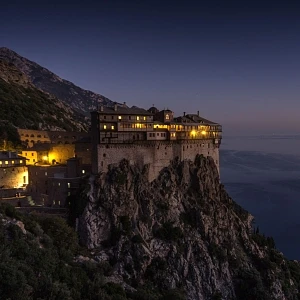
One of the most imposing monasteries of Mount Athos, the Holy Great Monastery of Simonos Petra is built on the edge of a steep granite rock and balances between heaven and earth, in a unique and impressive way. The majestic edifice is defined by a seven-story turreted building, on a large turreted base, it is located at a distance of about 300 m. from the sea and is actually a special example of bold Byzantine engineering. The historical life of the Holy Patriarchal Monastery of Simonopetra has a continuous course of approximately eight centuries, which ranks it in the 13th hierarchical position among the 20 monasteries of Mount Athos.
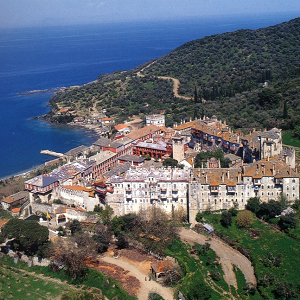
According to the tradition, in the 4th century AD, the Byzantine emperor Theodosius the Great (379–395 AD) laid the foundations for the reconstruction of the monastery, as a gesture of gratitude for the salvation of his son, Arkadius. Arcadius was sailing towards Rome, when suddenly the ship was wrecked and he himself was miraculously saved by the intervention of the Virgin Mary. Arkadius was found on the shores of the Athonian Peninsula, sleeping next to a reed.
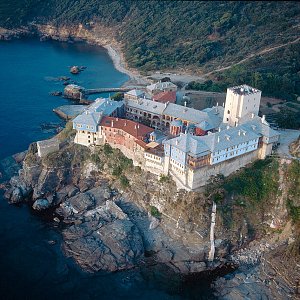
According to the tradition, the monastery's founder is considered to be the emperor Alexios Komnenos. However, official testimonies come to the conclusion that the founders of the Monastery were the brothers Alexios, the great general and John, the great Primitikirios. We do not know exactly when the construction of the monastery began, but in 1358 the monastery already existed and was possibly inaugurated in 1362 by the Patriarch of Constantinople Kallistos I'.
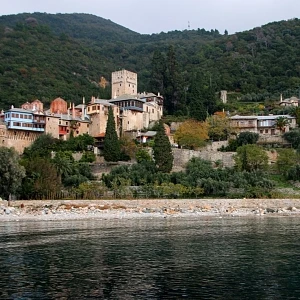
According to tradition, the founder of the Monastery of Dochiariou is considered to be the student and co-practitioner of Saint Athanasios the Athonite, Euthymios. The monk Euthymios had previously been a storekeeper at the Holy Monastery of Megistis Lavra. Initially, Euthymios founded, in the 10th century, a monastery in Dafni, dedicated to Saint Nikolaos. However, at the beginning of the 11th century, the Monastery was destroyed and moved to its current location.
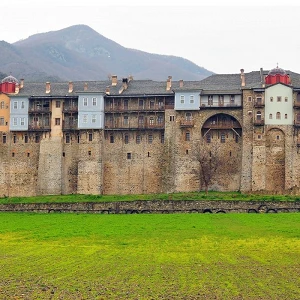
The Monastery of Iviron was originally founded in the 8th century and was known as the Monastery of Clement. However, in 980, a group of Georgian monks from the Great Lavra and under the guidance of the eminent monk John Tournikios, strengthened the monastery and made it a major power. Ioannis Tornikios as a monk was called by the emperor of Byzantium Basil II and together they suppressed the rebellion of the general Barda Skleros (or Sclerus). From the spoils and the imperial donations, the oldest monastery of Clement was enlarged and the Monastery of Iviron was created. Saint Ioannis and his natural son Saint Euthymios - founder of the monastery and later abbot - emerged as enlighteners of the monks in Iviron monastery.
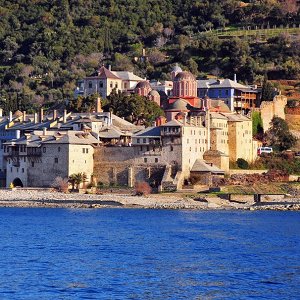
The founder of the Monastery is Saint Xenophon, who founded the monastery in 998 AD. and served as abbot. In the Third charter or Typikon, the Holy Monastery of Xenophon was in eighth place, while today the monastery's hierarchical position is the sixteenth. The Xenophon Monastery is dedicated to the Holy Great Martyr George the Trophy Bearer.
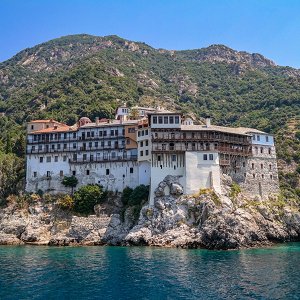
The Holy Monastery Grigoriou was founded in the period 1310-1314 by Saint Gregory the younger (December 7), the so-called hesychast and silent man. The Monastery is contemporary with the Holy Monasteries Dionysiou and Pantokrator, however, not much information is preserved about the activity of the Monastery during the first centuries. According to historical sources, Saint Gregory was a student of Saint Gregory of Sinai and lived in the Skete of Magoulas. Over time and as his spiritual children grew, Gregory decided to descend lower and build the Monastery in its current location.
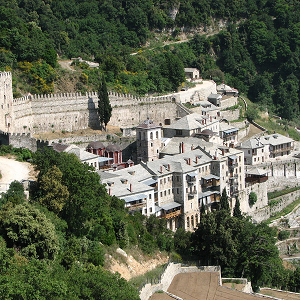
The founder of the monastery is Saint Paul of Xeropotamou, who was also the founder of the Xeropotamos monastery near Dafni, the port of Mount Athos. In fact, during the 10th and 11th centuries there are two monasteries with the name Xeropotamou on Mount Athos, since the current monastery of Agios Pavlos was established with this name permanently from 1108 onwards. At the beginning of the 14th century, the Monastery of Agios Pavlos was looted, destroyed and deserted. The successive hardships suffered by the Monastery made it a Cell, i.e. a part of the Xeropotamou Monastery. However, in 1365 the Monastery came under the jurisdiction of two Serbian monks of aristocratic origin, Gerasimos Radonias and Antonio Pigasis. Their presence particularly benefited the Monastery, which was recognized as eighteenth in the hierarchy of holy monasteries in the third Typical of 1394. A few years later, in 1401, the Holy Monastery of Xeropotamou recognizes for the first time as independent the Monastery of Agios Pavlos in an official document of the Patriarch Matthew.
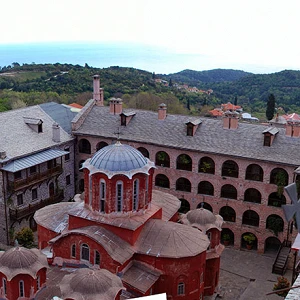
The Holy Monastery of Koutloumousi seems to be built before 1169, as it is mentioned in an official document of that year. The founder of the Monastery is considered to be a monk, called Kallistos, who came from the court of Koutloumos, progenitor of the Christianized Seljuk dynasty. From the first years of its foundation, the Monastery of Koutloumousi had as a benefactor the emperor Alexios I Comnenus, who helped the monastery to flourish.
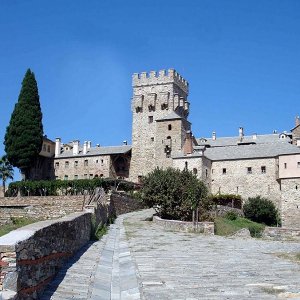
The beginning of the history Stavronikita Monastery is lost in the 10th and 11th centuries. Historical information and testimonies about the establishment of the Monastery are limited, however an official document of Protos Nikephoros in 1012, confirms that the Monastery functioned as a Cell since the 10th century. There are several versions of the foundation of the Stavronikita Monastery. It is most likely that the founder of the Monastery was an officer of Tsimiskis, named Nikitas or Stavronikitas Nikephoros. Also, there is also the hypothesis that the establishment of the Monastery is due to two monks, Stavros and Nikitas.
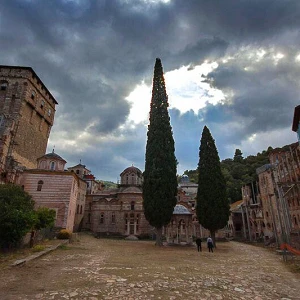
The name of the Monastery probably comes from the founder of the oldest monastery in the area, the hermit Grigorios Helandaris. Around 980 AD the monk Grigorios built, together with other monks, a small church and a small house, on the site where the Monastery is today. According to tradition, there is also the interpretation that the name of the Monastery is based on the etymology of the word "helandio" which is the Byzantine ship.